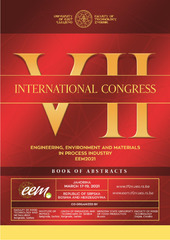Prikaz osnovnih podataka o dokumentu
IN VITRO ANTICANCER ACTIVITY STUDY ON SOME AZO PYRIDONE DYES DERIVED FROM DHPM SCAFFOLD
| dc.creator | Tadić, Julijana | |
| dc.creator | Lađarević, Jelena | |
| dc.creator | Stanojković, Tatjana | |
| dc.creator | Matić, Ivana | |
| dc.creator | Mijin, Dušan | |
| dc.date.accessioned | 2023-11-03T11:19:02Z | |
| dc.date.available | 2023-11-03T11:19:02Z | |
| dc.date.issued | 2021 | |
| dc.identifier.isbn | 978-99955-81-38-1 | |
| dc.identifier.uri | http://TechnoRep.tmf.bg.ac.rs/handle/123456789/6754 | |
| dc.description.abstract | In recent years, the growing interest in the synthesis of heterocyclic azo dyes can be assigned to a versatile application and biological activities such as antibacterial, antifungal, antioxidant, analgesic, antitubercular and anticancer, of these compounds. Azo dyes based on 2-pyridone core are important since they manifest a variety of biological properties, including potency for the cancer therapy. Moreover, DHPM (3,4-dihydropyrimidin-2(1H)-on) scaffold displays a wide range of biological activities, which has led to the development of numerous drug candidates, based on this structure. Since the cancer is one of the main targets in therapeutic chemistry, we have made an effort to design azo molecules with potential anticancer activity. In this direction, we have synthesized DHPM scaffold suitable for diazo coupling reaction with different 2-pyridones, in order to design a novel series of azo pyridone molecules. The chemical structures of obtained dyes have been confirmed by ATR-FTIR, NMR, UV-Vis, MS and elemental analysis. The antioxidant activity has been evaluated by ABTS (2,2’-azinobis-(3-ethylbenzothiazoline-6-sulfonic acid)) assay. In vitro antitumor action of DHPM precursor and related azo dyes was determined against prostate adenocarcinoma (PC-3), lung carcinoma (A549) and chronic myelogenous leukemia (K562) tumor cell lines, as well as against human normal lung fibroblast (MRC-5), using MTT (microculture tetrazolium test) assay. The physicochemical parameters, druglikeness and ADME properties of novel compounds were evaluated in silico by SwissADME. The ATR-FTIR and NMR spectroscopy confirmed that obtained dyes exist in hydrazone tautomeric form. The antioxidant assay evinced that three members of this dyes’ series are promising antioxidant candidates. Examination of cytotoxic effects on human cancer cell lines showed the concentration dependent cytotoxicity of all investigated compounds. It has been noted that cytotoxic activity of investigated dyes depends on the structure of pyridone moiety since DHPM adduct expressed low cytotoxic activity against all investigated cancer cell lines. All tested cancer cell lines were the most sensitive to the cytotoxic action of compound carrying 4-phenyl group in the pyridone moiety. Furthermore, this compound was particularly prominent and selective in cytotoxic action between K562 (24.97 μM) and PC-3 (48.98 μM) cancer cells, and normal MRC-5 (91.11 μM) cells. The last but not the least, ADME evaluation in silico has shown that all investigated compounds may be orally bioavailable. Altogether, it can be concluded that designed dyes’ molecules may serve for further structural modification and development of new anticancer drugs. | sr |
| dc.language.iso | en | sr |
| dc.publisher | Zvornik : University of East Sarajevo Faculty of Technology | sr |
| dc.rights | openAccess | sr |
| dc.rights.uri | https://creativecommons.org/licenses/by/4.0/ | |
| dc.source | Book of Abstracts / VII International Congress “Engineering, Environment and Materials in Process Industry” EEM 2021, 17-19 mart 2021, Jahorina, Bosna i Hercegovina | sr |
| dc.subject | hydrazone | sr |
| dc.subject | Biginelli synthesis | sr |
| dc.subject | antitumor action | sr |
| dc.subject | ADME | sr |
| dc.title | IN VITRO ANTICANCER ACTIVITY STUDY ON SOME AZO PYRIDONE DYES DERIVED FROM DHPM SCAFFOLD | sr |
| dc.type | conferenceObject | sr |
| dc.rights.license | BY | sr |
| dc.citation.spage | 243 | |
| dc.identifier.fulltext | http://TechnoRep.tmf.bg.ac.rs/bitstream/id/18315/bitstream_18315.pdf | |
| dc.identifier.rcub | https://hdl.handle.net/21.15107/rcub_technorep_6754 | |
| dc.type.version | publishedVersion | sr |

